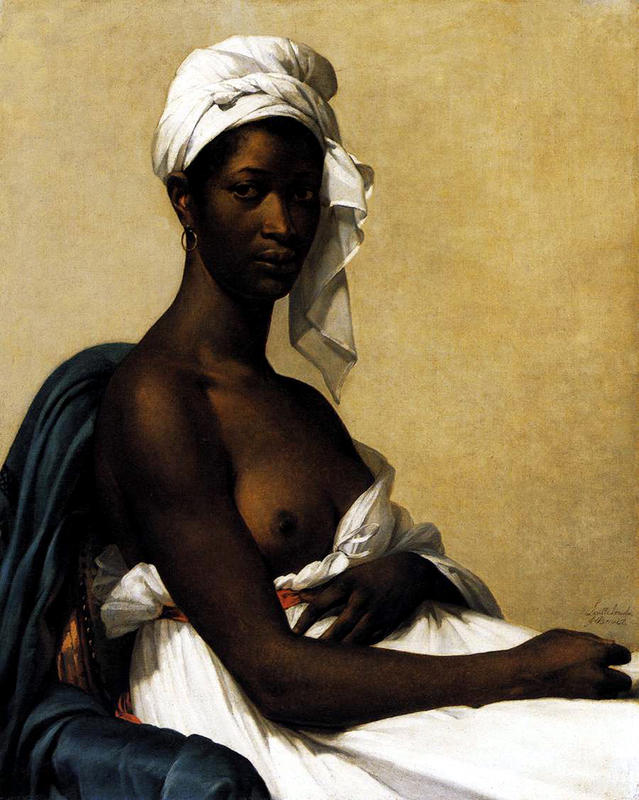More about Portrait of a Negress

Contributor
Benoist's striking 220-year old oil painting, retitled by curators, Portrait d'une femme noire, is an image of a woman who is not ashamed of herself...
...but who is still dressed, by her employer and landlady, in the typical outfit of the odalisque genre, which was softcore vintage porn for European men who liked brown and black women, but didn't want to admit that they collected porn, or that their sexual desires went "beyond the pale" to the "exotic" orient, or "darkest Africa," or any number of other gross, tired phrases.
When my mother was a teenager, she told her mother that she felt ashamed of her body. Grandma said, "But Jews don't feel ashamed of our bodies!" My mother felt ashamed of her shame and, decades later, taught me that society encourages people, especially women, to live in a constant state of shame, as if shame were humility. In the history of art, shame often appeared in the form of downcast eyes on nude models, postures which avoided contact with the viewer. Titian's Venus of Urbino, Wautier's self-portrait included in her Triumph of Bacchus, and Manet's Olympia all shifted the gaze of the nude woman upward, directly at the viewer. These women were not ashamed of their nudity, nor of their womanhood.
The historian Saidiya Hartman writes that the term "Negress" generally means "female slave," implying the infinite exchangeability of such human property. As you learn in intimate relationships, if you say, or even think, "you're replaceable," that's pretty much the end of the line! An even worse situation arises when you engage in economic relations for centuries, inventing life insurance and revolutionizing the banking industry by treating people as replaceable commodities without emotions, dignity, or inherent spiritual value.
In French, as in English, there are two types of woman. The "high" female is a "lady," like our first-generation immigrant grandmother: she drinks martinis while her maid, or slave, takes care of the children, the man of the house, and the housework. She's fancy. Like Benoist and Barney, she doesn't need to work for money, and she has to pretend she loves that arrangement, even if it's a "Yellow Wallpaper" by Charlotte Perkins Gilman type of situation. She is "kept" fancy by her husband or father. The "low" female is a woman, like my mother, who nurses and raises her own children. That is, when she's not raising someone else's, earning a living, or taking care of her husband. My mother insisted on using the word "woman" exclusively, instead of "lady," because it created a language of mutual recognition for women, and because feudalism, mostly, is over.
The Louvre, in an attempt to avoid political liability, has removed the artist's title of the painting, updating and making it more acceptable, according to both the grammar rules of my mother and the sensibilities of today. Portrait d'une femme noire is a quasi-feminist remix of the original title, but, ironically, unlike Benoist's original, ambiguous, and antiquated "negresse," it would have established the model as a person of "low birth" in the eyes of Benoist's society, as they could hardly have visualized the dame noire, or Black noblewoman.
Huey Copeland uses the ubiquitousness of the image, which appears on postcards for tourists to a Maryse Condé novel to a Christian Louboutin high heel ad, to say that it suggests the establishment of the "eternal captivity" of all black female subjects, even though it is an image of an specific individual person. The idea fits with the title of Copeland's book, Bound to Appear, as the model in Benoist's painting, never named by any curator or researcher, was kidnapped, her family forced to reproduce, physically and ideologically tied to a situation in which, after an installment in the Caribbean as a slave, she found herself posing for a painting by a white aristocrat. And now you can buy the image of her, and her exposed areola, on a postcard, so she's literally something to write home about. What would she say about all of that?
Sources
- Ballot, Marie-Juliette. Une élève de David la Comtesse Benoist L'Émilie de Demoustier, 1768-1826. Paris: Librairie Plon, 1914.
- Copeland, Huey. Bound to Appear: Art, Slavery, and the Site of Blackness in Multicultural America. Chicago: University of Chicago, 2013.
- Dagbovie-Mullins, Sika A. "Indelible Plantation Imprints in Trans-American Poetics." Anthurium: A Caribbean Studies Journal 11, Iss. 1 (2014): Article 7.
- Hartman, Saidiya. Wayward Lives, Beautiful Experiments: Intimate Histories of Social Upheaval. New York: W. W. Norton, 2019.
- Lidbury, Olivia. "Christian Louboutin’s shoes of art." The Telegraph, Jun 17, 2011, http://fashion.telegraph.co.uk/news-features/TMG8582008/Christian-Loubo….
- Rosenthal, Caroline, and Dirk Vanderbeke. Probing the Skin: Cultural Representations of Our Contact Zone. Cambridge: Cambridge Scholars Publishing, 2015.
- Rupprecht, Anita. "Excessive memories: Slavery, insurance and resistance." History Workshop Journal 64, no. 1 (2007): 6-28.
Featured Content
Here is what Wikipedia says about Portrait of Madeleine
Portrait of Madeleine, also known as Portrait of a Black Woman (French: Portrait d'une femme noire or Portrait d'une negresse), is an oil-on-canvas painting by the French artist Marie-Guillemine Benoist, created in 1800. It was exhibited at the Paris Salon of 1800, later was acquired by Louis XVIII for the French state in 1818, and remains in the collection of the Louvre.
Check out the full Wikipedia article about Portrait of Madeleine












